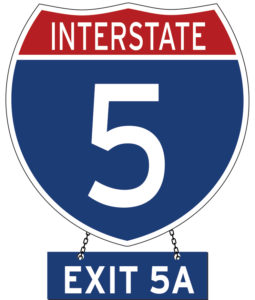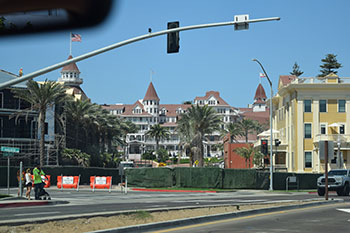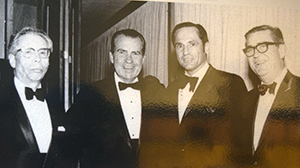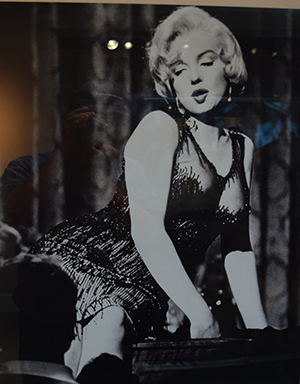 Schlepping and Schmoozing Along the Interstate 5: Chapter 7 (Exit 5A, CA 75-Palm Avenue); Hotel del Coronado.
Schlepping and Schmoozing Along the Interstate 5: Chapter 7 (Exit 5A, CA 75-Palm Avenue); Hotel del Coronado.
 Take westbound Freeway Exit Marked CA 75; Palm Ave. and for 5 ½ miles follow Palm Avenue (California 75) a surface road, as it becomes Silver Strand Boulevard nestled between the Pacific Ocean and San Diego Bay. Go past Loews another 4.3 miles to the Hotel del Coronado, which will be easily noticeable on the left.
Take westbound Freeway Exit Marked CA 75; Palm Ave. and for 5 ½ miles follow Palm Avenue (California 75) a surface road, as it becomes Silver Strand Boulevard nestled between the Pacific Ocean and San Diego Bay. Go past Loews another 4.3 miles to the Hotel del Coronado, which will be easily noticeable on the left.
Hollywood’s Marilyn Monroe, Tony Curtis, Billy Wilder, and Businessman M. Larry Lawrence Brought a Jewish Tam to the Local Landmark
The 757-room, Victorian-era, beachfront Hotel del Coronado, which opened in 1888, has hosted U.S. Presidents, British royalty, and movie and recording stars in its more than 130 years of existence
 It is more than a hotel; since 1977 it has been a national historic landmark. Its guests have included 11 U.S. President starting with Benjamin Harrison, who came a few years after its opening in 1888, and continuing with William Howard Taft, Franklin D. Roosevelt, Lyndon Johnson, Richard Nixon, Gerald Ford, Jimmy Carter, Ronald Reagan, George H. W. Bush, Bill Clinton, and George W. Bush.
It is more than a hotel; since 1977 it has been a national historic landmark. Its guests have included 11 U.S. President starting with Benjamin Harrison, who came a few years after its opening in 1888, and continuing with William Howard Taft, Franklin D. Roosevelt, Lyndon Johnson, Richard Nixon, Gerald Ford, Jimmy Carter, Ronald Reagan, George H. W. Bush, Bill Clinton, and George W. Bush.

On one memorable occasion – a 1970 State Dinner in the hotel’s Crown Room for Mexican President Gustavo Diaz Ordaz, three of those men were in attendance: Richard Nixon, who was then in office; former President Lyndon B. Johnson, and then-future President Ronald Reagan, who at the time was governor of California. Some of Reagan’s contemporaries from his Hollywood actor days also were in attendance, among them Frank Sinatra and John Wayne.
 As glamorous as that event may have been, visitors to the beachside Hotel del Coronado still buzz over photographs from 1958 when Marilyn Monroe, whose recent conversion to Judaism was associated with her marriage to playwright Arthur Miller, starred in the Billy Wilder movie Some Like It Hot, which was filmed on location at the “Del.” Her co-stars in the comedy were Jack Lemmon and Tony Curtis, whose characters tried to elude the mob by dressing in drag and joining an all-female band.
As glamorous as that event may have been, visitors to the beachside Hotel del Coronado still buzz over photographs from 1958 when Marilyn Monroe, whose recent conversion to Judaism was associated with her marriage to playwright Arthur Miller, starred in the Billy Wilder movie Some Like It Hot, which was filmed on location at the “Del.” Her co-stars in the comedy were Jack Lemmon and Tony Curtis, whose characters tried to elude the mob by dressing in drag and joining an all-female band.
To remember Monroe for the vacuous blonde showgirl whom she portrayed in that movie would do her a grave disservice, according to a 2018 exhibit at the Coronado Museum of History and Art, in which she was remembered as a force majeure in the movie industry, and a woman of far-ranging intellectual interests. According to the exhibit, Monroe revolted against the system under which actresses were paid less than their male co-stars and in which neither actor nor actress had any say in what roles they would be cast. To demonstrate she wasn’t going to put up with it anymore, she refused for one year to appear in any 20th Century Fox productions, creating her own company—Marilyn Monroe Productions—in the interim.
“By 1955, after the commercial success of the Seven Year Itch,” 20th Century Fox capitulated, signing a contract in which Monroe was guaranteed $100,000 per movie and was given control over what project she would accept. Additionally, she was accorded input on directors and cinematographers. This marked the end of the traditional studio system of Hollywood, the exhibit noted. “Marilyn’s takedown of the studio system in Hollywood proved that her screen persona of being a ditzy was just that—an act,” according to the exhibit. “She was driven to be a successful dramatic actress.”
During the time that Monroe stayed away from 20th Century Fox, she took acting lessons at the Actors Studio in New York, which was run by the legendary Lee Strasberg and his wife Paula. During the Some Like It Hot movie, Paula Strasberg was Monroe’s constant companion.
Another portion of the exhibit told of Monroe’s personal library, which included over 400 books on a variety of subjects. She had first editions of On the Road by Jack Kreouac; The Invisible Man by Ralph Ellison; and This House on Fire by William Styron. Other books in the collection included works by F. Scott Fitzgerald, James Joyce, Ernest Hemingway, Albert Camus, and Lewis Carroll.
Monroe, Curtis, and Lemmon together perhaps matched the star power of Edward, Prince of Wales, who visited San Diego County in 1920 while making a goodwill trip en route to Australia and New Zealand aboard HMS Renown. A legend, long promoted by the Del, was that while the Prince of Wales was at the hotel, he glimpsed Wallis Simpson, then the wife of the commander of the nearby North Island Naval Air Station. He later decided to marry her, causing a ruckus because she was a divorcee, and as king he was the ceremonial head of the Church of England.
In a famous declaration after only 327 days as King Edward VIII, he abdicated the throne “for the woman I love” – a romantic story as any. Edward VIII was succeeded by King George VI, who was the father of Queen Elizabeth II. At one point the Del named one of its public rooms after the Prince of Wales, and at another point, the management moved onto the property a cottage once occupied by Wallis Simpson, promoting the venue as a place for the romantic at heart to have their weddings.
However, after historians profiled Edward VIII as a covert Nazi sympathizer, his association with the hotel, while acknowledged, was downplayed. This was also true of such other Nazi sympathizers as Henry Ford and Charles Lindbergh.
Relatively recent hotel guests have included many movie stars and celebrities, including such Jewish A-listers as actor Seth Rogen, actress Julia Louis-Dreyfus, and producer/director Steven Spielberg.
Among the owners of the Del was M. Larry Lawrence, who purchased the Del in 1963 and doubled its capacity to 700 rooms, by adding two seven-story towers just south of the hotel. Lawrence, a member of the Jewish community for whose family the Lawrence Family JCC in a Jolla is named, popularized many fictional tales about the Del, including one that L. Frank Baum wrote portions of the Wizard of Oz while staying there. Supposedly, Baum was inspired by the cupolas atop the hotel. Lawrence also spun the tale that Thomas Edison himself supervised the installation of electricity at the venerable hotel.
Bill Clinton, a frequent guest at the Del during his presidency, appointed Lawrence as Ambassador to Switzerland, the post Lawrence held up to his death in 1996. He was buried initially at Arlington National Cemetery, but it was later learned that his tale of having served in the Merchant Marine was a fabrication, leading to his exhumation from the national cemetery and reburial at El Camino Memorial Park in San Diego. During the years that Lawrence owned the hotel, he was active in Democratic politics, and numerous office holders of that party trooped to the Del to ask for financial contributions, or to hold fundraisers or press conferences there. Meanwhile, Carleton Lichty, president of the Del, was active in the Republican party, drawing to the Del similar business from the GOP.
Adjacent to the hotel, on its south side, are the Coronado Towers, a condominium development that drew many investors from Mexico – so many, in fact, that they have often been jokingly referred to as “Taco Towers.” Numerous condominium owners there are Jewish, proudly displaying mezuzot on their doorposts.
*
Next Sunday, February 20, 2022: Exit 5B (Main Street) Sesame Place San Diego.
This story is copyrighted (c) 2022 by Donald H. Harrison, editor emeritus of San Diego Jewish World. He may be contacted via donald.harrison@sdjewishworld.com